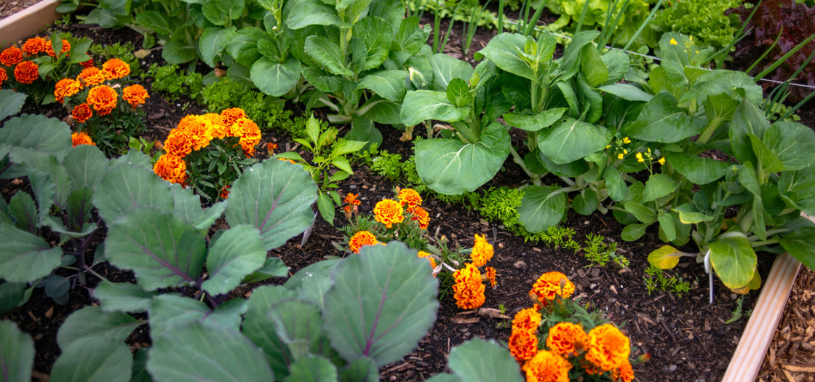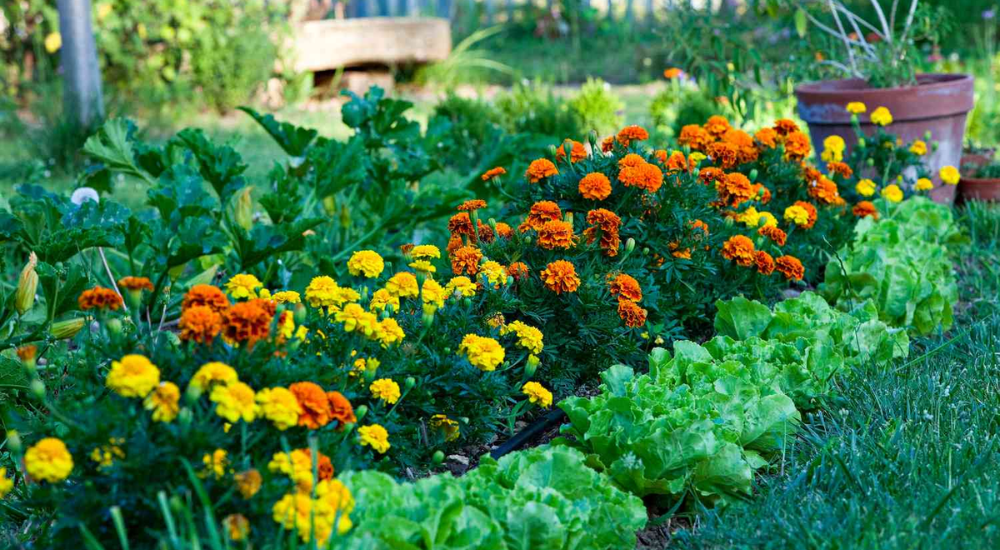Just like having a thoughtful neighbour, some plants grow better with a buddy next door. It’s called companion planting, which is all about pairing crops that naturally support each other. The result is healthier, more productive growth without any extra effort.
All you need to do is learn which plants make good companions and which ones should never mingle in your garden bed.
So, if you’re starting your very first veggie patch or adding to an established flower garden, we’ll walk you through the basics.
What is companion planting?
Companion planting or co-planting is the simple practice of growing plants side by side so they can help each other flourish. Some will act as natural pest control, keeping bugs at bay. Others improve the soil by adding nutrients. It’s nature’s way of creating balance in your garden.
Now that you know what companion planting is, let’s have a look at the benefits for your plants.

What are the benefits of companion planting?
In Melbourne’s mild climate and mixed soils, companion planting helps you grow strong, resilient plants. Below are some of the key ways the right plant pairings can make a difference in your garden.
Natural pest control
One of the most essential benefits of companion planting is natural pest protection. Strong-scented herbs like basil can repel aphids and whiteflies from nearby tomatoes. Nasturtiums, on the other hand, will act as decoys, luring pests away. With these natural defenders in place, you can rely less on chemical sprays.
Improved soil health
Companion plants work together below ground, too. Nitrogen-fixing plants like beans and peas actually enrich the soil for heavy feeders like corn and leafy greens. It’s like having a living fertiliser system built right into your garden bed.
Plants with deep taproots, such as carrots, will also pull minerals up from lower soil layers. Then, they’ll share the nutrients with their shallow-rooted neighbours.
Smarter use of space
Clever companion planting helps you make the most of every square metre in your garden. You can grow tall plants alongside shorter ones. Or, combine quick-growing crops with slower-maturing varieties. Lettuce, for example, can grow happily in the shade of taller plants, while radishes can be harvested before larger plants need the space.
Better flavours and growth
Some plant partnerships actually improve the taste and growth of their companions. The classic example is basil and tomatoes. They don't just taste great together on the plate. Basil actually enhances the flavour of tomatoes, while also protecting them from pests.
Attracting helpful pollinators
Flowering companion plants bring bugs, like bees, butterflies, and pest-eating insects. So, your garden becomes a balanced ecosystem that takes care of itself. This is especially important in urban Melbourne gardens where pollinators might be less common.
Clever companion planting chart
Use our quick-reference companion planting chart to see which plants grow best together — and which ones to keep apart.
For more seasonal advice on when to plant these crops, check out our comprehensive vegetable planting guide.
Companion planting for fruit and vegetables
Carrots
Carrots are vulnerable to insects and grow best with strong-scented neighbours that mask their scent.
What to plant carrots with:
- Onions – Their sharp smell deters carrot flies. Plant in alternating rows.
- Leeks – Offer similar protection from pests.
- Rosemary – Repels carrot pests when planted close by.
- Lettuce – Makes use of space without competing for soil.
Avoid planting with: Dill and parsnips, as they attract the same pests and diseases.
Garlic
Garlic is a natural pest deterrent and strong protector for nearby plants.
What to plant garlic with:
- Roses – Keep aphids away and support healthy blooms.
- Tomatoes – Deters red spider mites and other pests.
Avoid planting with: Peas and beans, as garlic can slow their growth.
Onions
Onions protect their neighbours with a strong scent that drives away insects.
What to plant onions with:
- Carrots – Classic partners that protect each other.
- Beetroot – Grows well alongside onions without competing.
- Lettuce – Benefits from onion’s pest-repelling properties.
- Strawberries – Onions deter pests that target berry plants.
Avoid planting with: Beans and peas, as onions can slow their growth.
Spinach
Spinach benefits from nitrogen-rich companions and fast-growing crops that don’t compete for space.
What to plant spinach with:
- Peas – Add nitrogen to the soil, strengthening spinach growth.
- Beans – Provide similar soil benefits.
- Radishes – Mature quickly, freeing up space for spinach leaves.
- Strawberries – Act as ground cover to keep soil moist.
Avoid planting with: Potatoes, which crowd spinach roots.
Strawberries
Strawberries benefit from leafy companions that shade the soil and flowers that attract pollinators.
What to plant strawberries with:
- Spinach – Helps cool the soil and prevent weeds.
- Lettuce – Shallow roots mean no competition.
- Rhubarb – Provides structure and natural shade.
- Borage – Attracts bees and may improve berry flavour.
Avoid planting with: Cabbages and other brassicas, which compete too heavily for nutrients.
Tomatoes
Tomatoes are heavy feeders that benefit from pest protection and soil support.
What to plant tomatoes with:
- Basil – Repels aphids and may boost flavour. Plant 15–20cm from stems.
- Carrots – Loosen the soil and grow well before tomatoes spread.
- Onions – Scent deters aphids and thrips. Grow in alternating rows.
- Marigolds – Deter nematodes and attract pollinators as a border crop.
Avoid planting with: Potatoes, corn, and fennel, as they share pests, spread disease, and compete for nutrients.
Zucchini
Zucchini are fast growers that need plenty of room.
What to plant zucchini with:
- Nasturtiums – Lure aphids away from zucchini leaves. Let them trail at the base.
- Beans – Add nitrogen to the soil, boosting zucchini growth.
- Corn – Provides light shade and wind protection. Plant in rows alongside.
Avoid planting with: Potatoes, which compete for nutrients and space.
Companion planting for herbs
Basil
Basil protects crops from pests and may even improve their flavour.
What to plant basil with:
- Tomatoes – Repels aphids and whiteflies, while boosting flavour.
- Capsicum – Benefits from basil’s pest-repelling oils.
Avoid planting with: Rue, as it can stunt basil’s growth.
Coriander
Coriander grows well with cool-season crops and helps deter pests.
What to plant coriander with:
- Carrots – Pairs well and helps mask the carrot scent.
- Spinach – Both thrive in cooler weather and don’t compete.
Avoid planting with: Fennel, which can inhibit growth.
Dill
Dill attracts beneficial insects but needs the right neighbours.
What to plant dill with:
- Cabbages – Protects against cabbage worms.
- Cucumbers – Attracts pollinators that improve yields.
Avoid planting with: Carrots, as they attract the same pests.
Companion planting for flowers
Marigolds
Marigolds are natural pest repellents that also attract pollinators.
What to plant marigolds with:
- Tomatoes – Repel nematodes and aphids, protecting tomato roots.
- Beans – Keep soil pests at bay and encourage beneficial insects.
Avoid planting with: Basil, if planted too close, as they may compete for space and nutrients.
Nasturtiums
Nasturtiums act as a trap crop that lures pests away from vegetables.
What to plant nasturtiums with:
- Zucchini – Protects leaves by attracting aphids to itself.
- Cucumbers – Draw pests away and improve ground cover.
Avoid planting with: Brassicas (like cabbage), as nasturtiums can also attract cabbage moths.
Sunflowers
Sunflowers provide height, shade, and support for climbing plants.
What to plant sunflowers with:
- Beans – Climb sunflowers for natural support.
- Cucumbers – Benefit from shade and attract pollinators.
Avoid planting with: Potatoes, as they compete for nutrients and space.
Find your plant’s perfect pair at All Green Nursery
By matching the right plants, you can enjoy healthier, tastier harvests. Start small by pairing a few favourites, like tomatoes and basil or zucchini and nasturtiums, and build from there. Over time, you’ll create a garden that almost takes care of itself.


.png)




